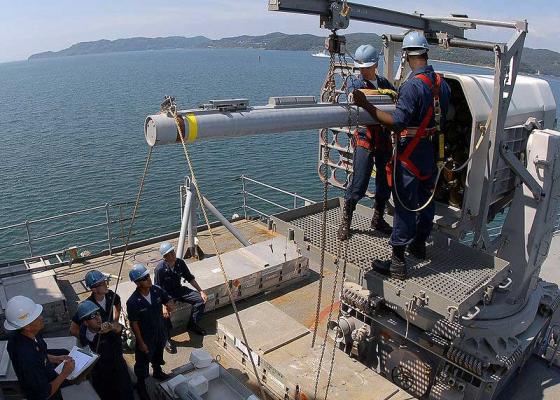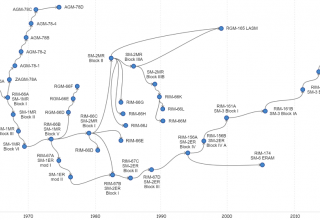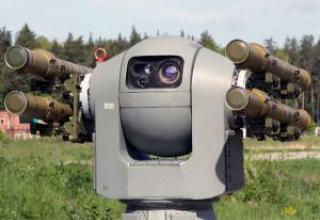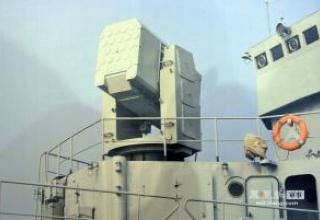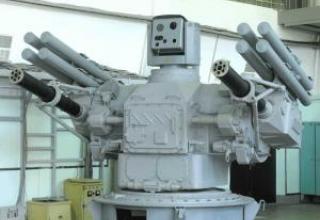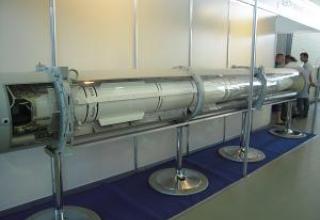RAM (Rolling Airframe Missile) - Short range anti-aircraft missile is a part of ASMD anti-aircraft missile defense system, designed to protect ships in the near zone of air defense against massive attacks of low-flying cruise missiles with a low level of masking signs.
The complex was created jointly by the U.S., Germany and Denmark and adopted for service in 1987. The missile is produced by cooperation between the companies Raytheon (USA) and RAMSYS (Germany). The RAM SAM system is in service with more than 100 ships of the US Navy, Germany, Greece, Korea, Egypt, Turkey and the United Arab Emirates.
The missile design is based on components of existing SAMs and air-to-air missiles. In particular, it was designed using infrared GSN from the Stinger missile and the engine, combat unit and fuse from the Sidewinder aircraft missile.
At present, the developers offer an upgraded version of the RAM Block 2 rocket, which is notable for its extended range and maneuverability.
Composition:
RAM (Rim-116) - is a nonstabilized heeleded missile equipped with an autonomous, combined (passive radar and infrared) homing system.
Passive infrared (IR) guidance provides RAM with the required accuracy and autonomy, but has a limited range, especially when intercepting low-flying targets on counter courses. In addition, the infrared homing head has a narrow field of view. To compensate for this shortcoming, the initial pointing of the SAM is provided by the passive radar CNS. This is due to the fact that most anti-ship missiles (SLCMs) have active on-board radio altimeters or active CNS at the final point of attack of a surface ship, and the missiles are radio emitting targets.
Guidance through the radar channel is provided by a radio interferometer with two forward looking antennas located in the forward section of the missile. These antennas receive signals from the attacking PCR. The rear view antennas are located in the tail of the LLS to communicate with the ship's detection radar and transmit initial target data. The fragmentation warhead is detonated by an optical non-contact fuse.
The RAM Block 2 rocket (see Photo1, Photo2) is equipped with a 30% increased fuel charge marshal engine, independent steering drives providing stabilization and control through all channels. Dual-mode homing head, control system hardware and software have also been upgraded.
Two main versions of ASMD SAMs were developed:
- Stand-alone EX-31 with 24 starting containers mounted on a modified carriage of the Phalanx high-speed gun carriage (with azimuth and angle drive systems),
- RAM Orbalt" variant, which is two upper central modules of the Mk29 Sea Sparrow SAM system with five missiles in each module.
Equipping ships with the RAM system is not technically difficult, its combat application can be ensured by the existing ship's target detection and tracking equipment and firing control systems with minor modifications.
As the main drawback of this SAM system, western specialists point out the possibility to point the RAM (RIM-116A) missile at the initial section of the trajectory only at the radio emitting targets.
Characteristics:
| Range, m: - minimum - maximum |
500 10000 |
| Minimal intercept height, m. | 4 |
| Maximum speed of targets to be hit, m/s | 700 |
| Response time, s | 5-10 |
| ZUR kit | 11 |
| Maximum flight speed of ZUR, m/s | 700 |
| The length of the rocket, mm | 2800 |
| The diameter of the rocket body, mm | 127 |
| Wingspan, mm | 430 |
| Start weight, kg | 73.5 |
| Weight of combat unit, kg | 9-10 |
Testing:
R-3C was baptized in battle in Vietnam and then in the Middle East. It proved to be a good weapon, unpretentious and reliable. However, TGSN R-3S was sensitive to weather conditions (rain and cloud cover absorbed infrared radiation), the attack was possible only from the rear hemisphere, and to evade it, the enemy used to evade the sun - a powerful natural source of heat (at night such a false target could be a "cold" moon). The launch performance was also affected by the missile's limited maneuverability when flying to the target, its inability to descend from the track at high overloads in combat and insufficiently powerful combat unit. The area of possible attacks was also reduced by the minimum allowed range (it was determined by the inability of the TGSN to track the target moving fast on azimuth and its own safety in case of a BC explosion).
For 1966. - the first year of use of R-ZS missiles in Vietnam, they were hit by 16 out of 57 American aircraft shot down by fighter aircraft. Their efficiency was 35% at 46 launches. Skills and more careful observance of tactical recommendations allowed next year to increase the effectiveness of missile attacks: in 53 battles MiG-21 shot down 50 planes. The overwhelming majority of R-3C launches were carried out from behind at short ranges (1200 - 2500m), only 5% of the attacks were carried out from distances over 2500m.
Shortcomings in training and tactics affected the use of missiles in the Middle East battles: sharp maneuvers of impulsive Arab pilots who did not comply with the prescribed modes of launch, led to unsuccessful launches and wasted missiles. Thus, in the group battle on November 3, 1968, the price of victory over two Israeli "Mirages" was 13 spent by the Egyptians R-3C. In the Indo-Pakistan conflict in December 1971, out of 10 victories won by Indian MiG-21, 8 were achieved with the use of guns and only 2 with the launch of R-3C.
Sources:
- Б.И. Радионов Н.Н. Новиков "Крылатые ракеты в морском бою" 1987 г.
- http: // www.fas.org

